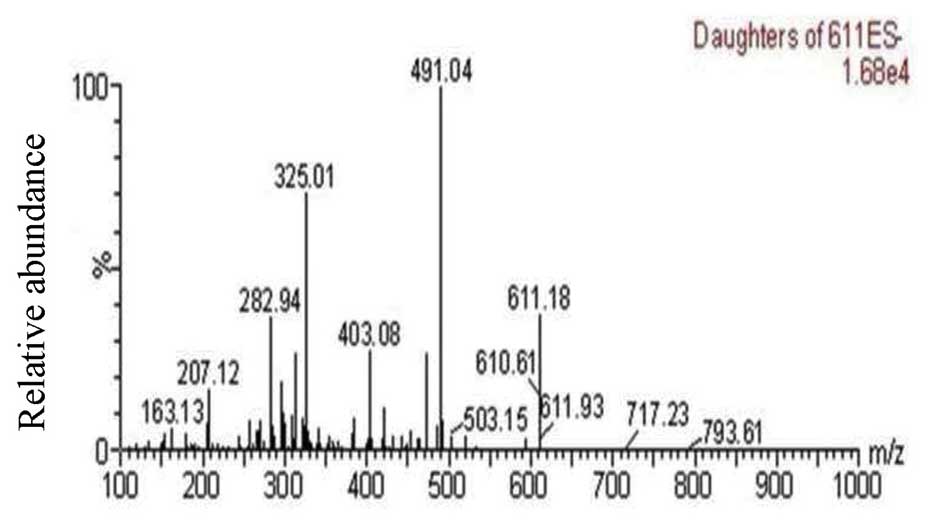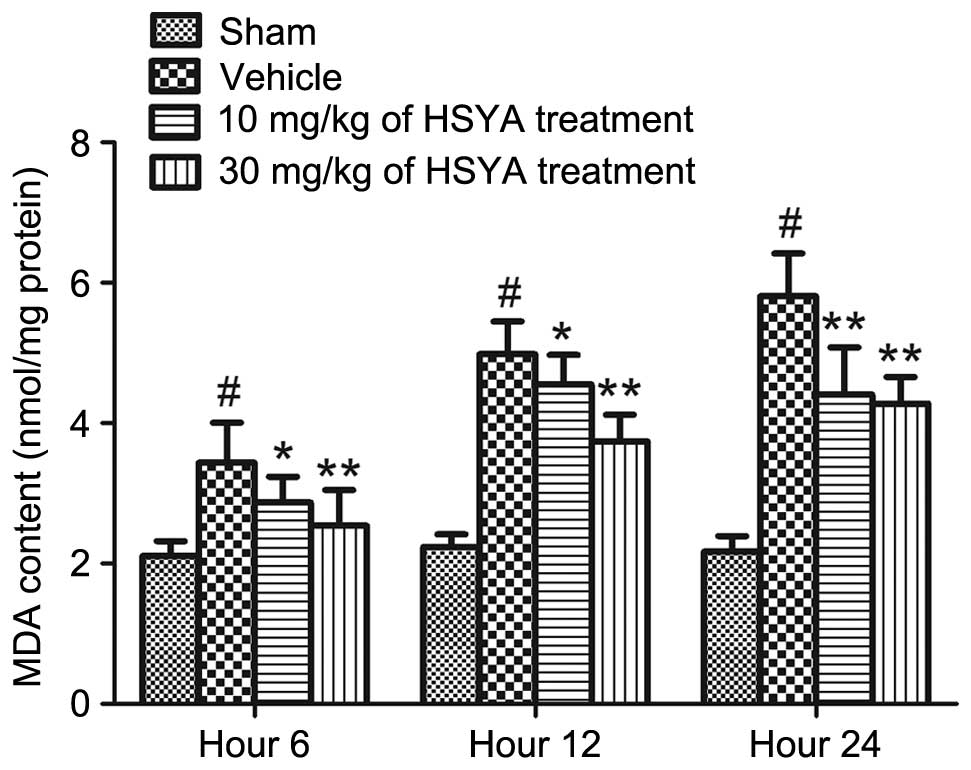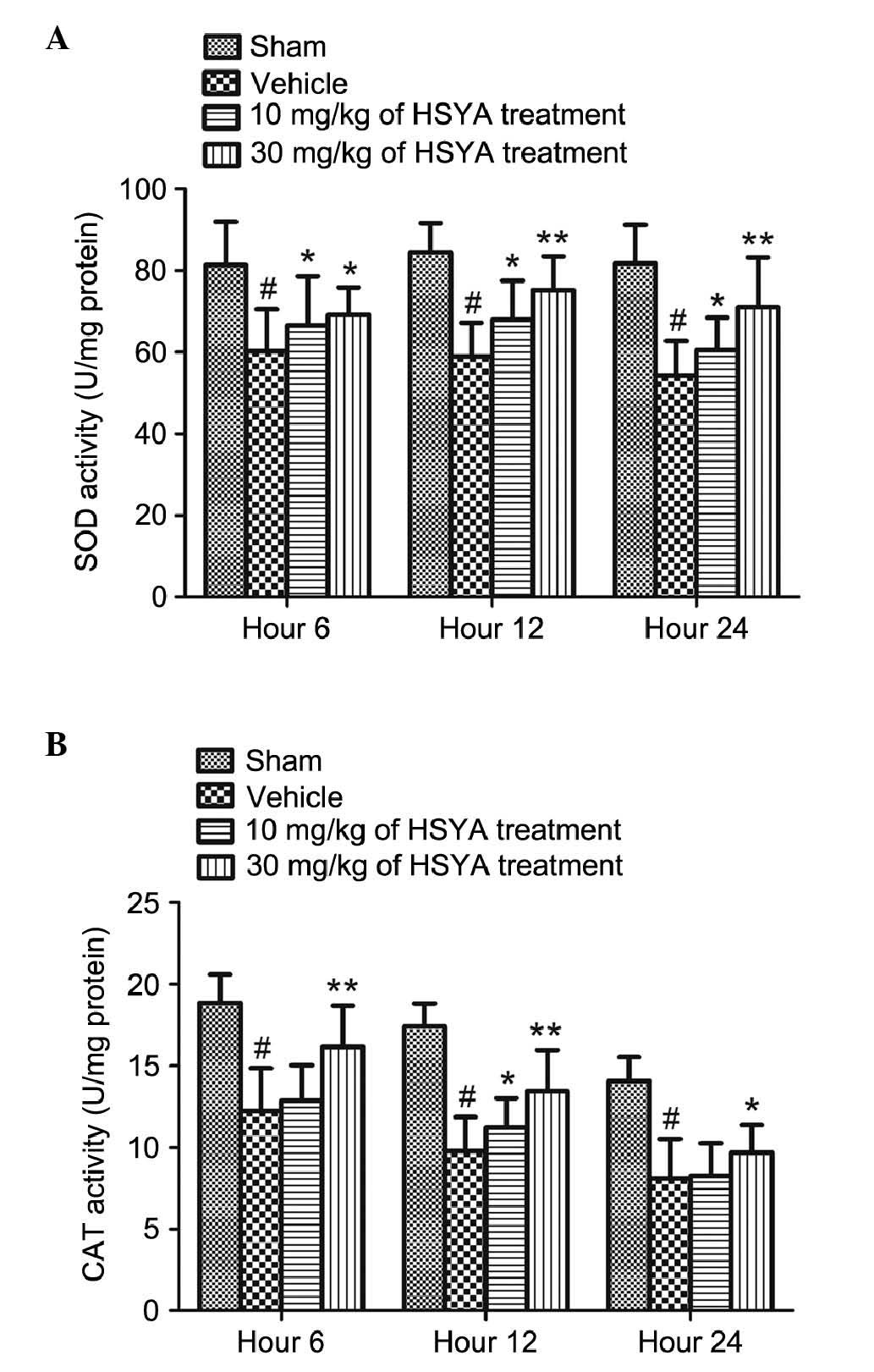|
1
|
Harrison-Felix C, Kolakowsky-Hayner SA,
Hammond FM, Wang R, Englander J, Dams-O'Connor K, Kreider SE,
Novack TA and Diaz-Arrastia R: Mortality after surviving traumatic
brain injury: Risks based on age groups. J Head Trauma Rehabil.
27:E45–E56. 2012. View Article : Google Scholar : PubMed/NCBI
|
|
2
|
Roozenbeek B, Maas AI and Menon DK:
Changing patterns in the epidemiology of traumatic brain injury.
Nat Rev Neurol. 9:231–236. 2013. View Article : Google Scholar : PubMed/NCBI
|
|
3
|
Corps KN, Roth TL and McGavern DB:
Inflammation and neuroprotection in traumatic brain injury. JAMA
Neurol. 72:355–362. 2015. View Article : Google Scholar : PubMed/NCBI
|
|
4
|
Wu X, Hu J, Zhuo L, Fu C, Hui G, Wang Y,
Yang W, Teng L, Lu S and Xu G: Epidemiology of traumatic brain
injury in eastern China, 2004: A prospective large case study. J
Trauma. 64:1313–1319. 2008. View Article : Google Scholar : PubMed/NCBI
|
|
5
|
Tuominen R, Joelsson P and Tenovuo O:
Treatment costs and productivity losses caused by traumatic brain
injuries. Brain Inj. 26:1697–1701. 2012. View Article : Google Scholar : PubMed/NCBI
|
|
6
|
Lei J, Gao G and Jiang J: Acute traumatic
brain injury: Is current management evidence based? An empirical
analysis of systematic reviews. J Neurotrauma. 30:529–537. 2013.
View Article : Google Scholar
|
|
7
|
Kou K, Hou XY, Sun JD and Chu K: Current
pre-hospital traumatic brain injury management in China. World J
Emerg Med. 5:245–254. 2014. View Article : Google Scholar : PubMed/NCBI
|
|
8
|
Jin W, Wang H, Yan W, Zhu L, Hu Z, Ding Y
and Tang K: Role of Nrf2 in protection against traumatic brain
injury in mice. J Neurotrauma. 26:131–139. 2009. View Article : Google Scholar : PubMed/NCBI
|
|
9
|
Smith JA, Park S, Krause JS and Banik NL:
Oxidative stress, DNA damage and the telomeric complex as
therapeutic targets in acute neurodegeneration. Neurochem Int.
62:764–775. 2013. View Article : Google Scholar : PubMed/NCBI
|
|
10
|
Adibhatla RM and Hatcher JF: Lipid
oxidation and peroxidation in CNS health and disease: From
molecular mechanisms to therapeutic opportunities. Antioxid Redox
Sign. 12:125–169. 2010. View Article : Google Scholar
|
|
11
|
Hall ED, Detloff MR, Johnson K and Kupina
NC: Peroxynitrite-mediated protein nitration and lipid peroxidation
in a mouse model of traumatic brain injury. J Neurotrauma. 21:9–20.
2004. View Article : Google Scholar : PubMed/NCBI
|
|
12
|
Sun L, Yang L, Xu YW, Liang H, Han J, Zhao
RJ and Cheng Y: Neuroprotection of hydroxysafflor yellow A in the
transient focal ischemia: Inhibition of protein
oxidation/nitration, 12/15-lipoxy-genase and blood-brain barrier
disruption. Brain Res. 1473:227–235. 2012. View Article : Google Scholar : PubMed/NCBI
|
|
13
|
Fan L, Dang X, Shi Z, Zhang C and Wang K:
Hydroxysafflor yellow A protects PC12 cells against the apoptosis
induced by oxygen and glucose deprivation. Cell Mol Neurobiol.
31:1187–1194. 2011. View Article : Google Scholar : PubMed/NCBI
|
|
14
|
Gracy RW, Talent JM, Kong Y and Conrad CC:
Reactive oxygen species: The unavoidable environmental insult?
Mutat Res. 428:17–22. 1999. View Article : Google Scholar : PubMed/NCBI
|
|
15
|
Pharmacopoeia Commission of PRC:
Pharmacopoeia of the People's Republic of China. Chemical Industry
Press; Beijing: pp. 1412010
|
|
16
|
Qi Z, Yan F, Shi W, Dong W, Zhao Y, Shen
J, Ji X, Liu KJ and Luo Y: AKT-related autophagy contributes to the
neuroprotective efficacy of hydroxysafflor yellow A against
ischemic stroke in rats. Transl Stroke Res. 5:501–509. 2014.
View Article : Google Scholar : PubMed/NCBI
|
|
17
|
Li J, Zhang S, Lu M, Chen Z, Chen C, Han
L, Zhang M and Xu Y: Hydroxysafflor yellow A suppresses
inflammatory responses of BV2 microglia after oxygen-glucose
deprivation. Neurosci Lett. 535:51–56. 2013. View Article : Google Scholar : PubMed/NCBI
|
|
18
|
Bie XD, Han J and Dai HB: Effects of
hydroxysafflor yellow A on the experimental traumatic brain injury
in rats. J Asian Nat Prod Res. 12:239–247. 2010. View Article : Google Scholar : PubMed/NCBI
|
|
19
|
Guo Y, Wang Y, Huang X, Lv H, Fan R, Huang
W, Gan P, Liu W, Yan K, Xia Z and Liu J: Determination of
hydroxysafflor yellow A in biological fluids of patients with
traumatic brain injury by UPLC-ESI-MS/MS after injection of
Xuebijing. Biomed Chromatogr. 28:1090–1095. 2014. View Article : Google Scholar : PubMed/NCBI
|
|
20
|
Sharma SK and Babitch JA: Application of
Bradford's protein assay to chick brain subcellular fractions. J
Biochem Biophys Methods. 2:247–250. 1980. View Article : Google Scholar : PubMed/NCBI
|
|
21
|
Zhao H, Chai W, Gao W, Xu L, Zhang H and
Yang Y: Hyperoxygenated solution: Effects on acute hypobaric
hypoxia-induced oxidative damage in rabbits. High Alt Med Biol.
10:283–291. 2009. View Article : Google Scholar : PubMed/NCBI
|
|
22
|
Wang Y, Huang X, Liang Q, Fan R, Qin F,
Guo Y, Yan KP, Liu W, Luo JK, Li YH, et al: A strategy for
detecting absorbed bioactive compounds for quality control in water
extract of rhubarb by ultra performance liquid chromatography with
photodiode array detector. Chin J Integr Med. 18:690–698. 2012.
View Article : Google Scholar : PubMed/NCBI
|
|
23
|
Qi J, Zhuang J, Wu W, Lu Y, Song Y, Zhang
Z, Jia J and Ping Q: Enhanced effect and mechanism of water-in-oil
microemulsion as an oral delivery system of hydroxysafflor yellow
A. Int J Nanomedicine. 6:985–991. 2011. View Article : Google Scholar : PubMed/NCBI
|
|
24
|
Lv LZ, Tong CQ, Yu J, Han M and Gao JQ:
Mechanism of enhanced oral absorption of hydrophilic drug
incorporated in hydrophobic nanoparticles. Int J Nanomedicine.
8:2709–2717. 2013.PubMed/NCBI
|
|
25
|
Wei X, Liu H, Sun X, Fu F, Zhang X, Wang
J, An J and Ding H: Hydroxysafflor yellow A protects rat brains
against ischemia-reperfusion injury by antioxidant action. Neurosci
Lett. 386:58–62. 2005. View Article : Google Scholar : PubMed/NCBI
|
|
26
|
Zhu H, Wang Z, Ma C, Tian J, Fu F, Li C,
Guo D, Roeder E and Liu K: Neuroprotective effects of
hydroxysafflor yellow A: In vivo and in vitro studies. Planta Med.
69:429–433. 2003. View Article : Google Scholar : PubMed/NCBI
|
|
27
|
Habgood MD, Bye N, Dziegielewska KM, Ek
CJ, Lane MA, Potter A, Morganti-Kossmann C and Saunders NR: Changes
in blood-brain barrier permeability to large and small molecules
following traumatic brain injury in mice. Eur J Neurosci.
25:231–238. 2007. View Article : Google Scholar : PubMed/NCBI
|
|
28
|
Wang CY, Liu Q, Huang QX, Liu JT, He YH,
Lu JJ and Bai XY: Activation of PPARγ is required for
hydroxysafflor yellow A of Carthamus tinctorius to attenuate
hepatic fibrosis induced by oxidative stress. Phytomedicine.
20:592–599. 2013. View Article : Google Scholar : PubMed/NCBI
|
|
29
|
Mojtahedzadeh M, Ahmadi A, Mahmoodpoor A,
Beigmohammadi MT, Abdollahi M, Khazaeipour Z, Shaki F, Kuochaki B
and Hendouei N: Hypertonic saline solution reduces the oxidative
stress responses in traumatic brain injury patients. J Res Med Sci.
19:867–874. 2014.PubMed/NCBI
|
|
30
|
Gan L, Wang ZH, Zhang H, Zhou R, Sun C,
Liu Y, Si J, Liu YY and Wang ZG: Protective effects of shikonin on
brain injury induced by carbon ion beam irradiation in mice. Biomed
Environ Sci. 28:148–151. 2015.PubMed/NCBI
|
|
31
|
Li J and Wang Y: Effect of different
methods of hypoxic exercise training on free radical oxidation and
antioxidant enzyme activity in the rat brain. Biomed Rep.
1:925–929. 2013.
|
|
32
|
Xie Z, Lei B, Huang Q, Deng J, Wu M, Shen
W and Cheng Y: Neuroprotective effect of Cyclosporin A on the
development of early brain injury in a subarachnoid hemorrhage
model: A pilot study. Brain Res. 1472:113–123. 2012. View Article : Google Scholar : PubMed/NCBI
|
|
33
|
Yakovlev AG, Knoblach SM, Fan L, Fox GB,
Goodnight R and Faden AI: Activation of CPP32-like caspases
contributes to neuronal apoptosis and neurological dysfunction
after traumatic brain injury. J Neurosci. 17:7415–7424.
1997.PubMed/NCBI
|
|
34
|
Kim JY, Kim N, Yenari MA and Chang W:
Hypothermia and pharmacological regimens that prevent
overexpression and overactivity of the extracellular
calcium-sensing receptor protect neurons against traumatic brain
injury. J Neurotrauma. 30:1170–1176. 2013. View Article : Google Scholar : PubMed/NCBI
|
|
35
|
Schoch KM, Evans HN, Brelsfoard JM,
Madathil SK, Takano J, Saido TC and Saatman KE: Calpastatin
overexpression limits calpain-mediated proteolysis and behavioral
deficits following traumatic brain injury. Exp Neurol. 236:371–382.
2012. View Article : Google Scholar : PubMed/NCBI
|
|
36
|
Sullivan PG, Rabchevsky AG, Waldmeier PC
and Springer JE: Mitochondrial permeability transition in CNS
trauma: Cause or effect of neuronal cell death? J Neurosci Res.
79:231–239. 2005. View Article : Google Scholar
|
|
37
|
Alexi T, Borlongan CV, Faull R, Williams
CE, Clark RG, Gluckman PD and Hughes PE: Neuroprotective strategies
for basal ganglia degeneration: Parkinson's and Huntington's
diseases. Prog Neurobiol. 60:409–470. 2000. View Article : Google Scholar : PubMed/NCBI
|
|
38
|
Bar-Or D, Bar-Or R, Rael LT and Brody EN:
Oxidative stress in severe acute illness. Redox Biol. 4:340–345.
2015. View Article : Google Scholar : PubMed/NCBI
|
|
39
|
Ehsaei M, Khajavi M, Arjmand MH, Abuee MA,
Ghayour-Mobarhan M and Hamidi Alamdari D: Prooxidant-antioxidant
balance in patients with traumatic brain injury. Acta Neurol Belg.
115:69–73. 2015. View Article : Google Scholar
|
|
40
|
Freire MA: Pathophysiology of
neurodegeneration following traumatic brain injury. West Indian Med
J. 61:751–755. 2012.
|
|
41
|
Xue T, Luo P, Zhu H, Zhao Y, Wu H, Gai R,
Wu Y, Yang B, Yang X and He Q: Oxidative stress is involved in
Dasatinib-induced apoptosis in rat primary hepatocytes. Toxicol
Appl Pharmacol. 261:280–291. 2012. View Article : Google Scholar : PubMed/NCBI
|
|
42
|
Lau WK, Mak JC, Chan KH and Law AC:
Cigarette smoke-induced cerebral cortical interleukin-6 elevation
is not mediated through oxidative stress. Neurotox Res. 22:170–176.
2012. View Article : Google Scholar :
|
|
43
|
Zelko IN, Mariani TJ and Folz RJ:
Superoxide dismutase multigene family: A comparison of the CuZn-SOD
(SOD1), Mn-SOD (SOD2), and EC-SOD (SOD3) gene structures,
evolution, and expression. Free Radic Biol Med. 33:337–349. 2002.
View Article : Google Scholar : PubMed/NCBI
|
|
44
|
Chelikani P, Fita I and Loewen PC:
Diversity of structures and properties among catalases. Cell Mol
Life Sci. 61:192–208. 2004. View Article : Google Scholar : PubMed/NCBI
|
|
45
|
Ansari MA, Roberts KN and Scheff SW:
Oxidative stress and modification of synaptic proteins in
hippocampus after traumatic brain injury. Free Radic Biol Med.
45:443–452. 2008. View Article : Google Scholar : PubMed/NCBI
|
|
46
|
Wang D, Yuan X, Liu T, Liu L, Hu Y, Wang Z
and Zheng Q: Neuroprotective activity of lavender oil on transient
focal cerebral ischemia in mice. Molecules. 17:9803–9817. 2012.
View Article : Google Scholar : PubMed/NCBI
|















